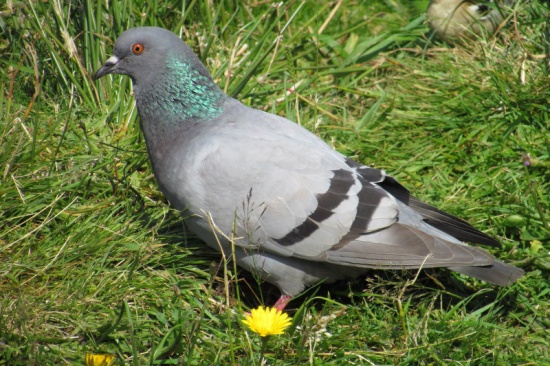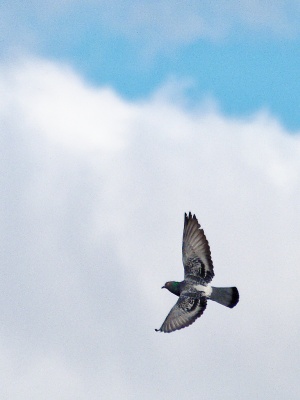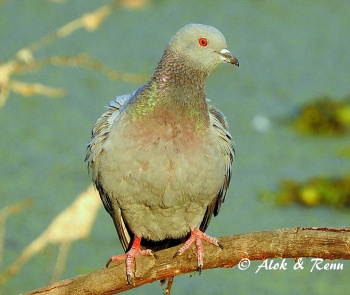Alternative names: Rock Dove; also Feral Pigeon or Common Pigeon for feral populations.
- Columba livia
Identification
Length 30–35 cm (12¼-13½ in), wingspan 62–68 cm, weight 180–350 g
Overall blue-grey, with two broad black bars on the pale grey wings, white lower back, and light grey rump. The head and neck of adults is a darker blue-grey than the back and wings; the lower back is white, and the underwing coverts pale whitish grey. The green and lilac or purple patch on the side of the neck is large, and the tail is distinctly banded black at the tip.
Eye colour of the pigeon is generally an orange colour but a few pigeons may have white-grey eyes. The eyelids are orange in colour and are encapsulated in a grey-white eye ring. The feet are red to pink. The bill is dark grey and slender, with a small white cere at the base of the upper mandible.
Young birds show little iridescence and are duller.
Variations
Feral birds show a variety of different colouration, generally due to having a homing pigeon background, these include black and white chequering, dark grey, light and bluish grey, grey and white, pinky brown, peach and either partly or wholly white. They may have a stouter bill and larger white cere.
Similar species
Hill Pigeon is very similar and replaces Rock Dove from central to north-eastern Asia but with much overlap with invading Feral Pigeons; it differs primarily in having a white band on the mid-tail (thus, with the lower back, two white bands in flight, to Rock Dove's one white band). Stock Dove is less similar, differing in only small black bars on the wing, darker grey wing (both above and below), less extensive glossy neck patch, and no white; it is also usually separated by habitat (primarily a woodland bird), though they can often be found feeding together.
Distribution
Wild populations are found in southern and western Europe, northern and western Africa, and southwestern to central Asia.
Rock Pigeons have been domesticated for several thousand years; escapees have resulted in feral populations in towns and cities world-wide, and also colonising natural habitats such as the sea cliffs of eastern England. Few (if any) wild populations are free of the influence of feral birds.
Taxonomy
Subspecies
Different authorities accept 9 (IOC) to 13 (Clements) subspecies:[1][2]
- C. l. livia
- Western and southern Europe, northern Africa, southwestern Asia
- C. l. atlantis
- Madeira, Azores and Cape Verde Islands (included in C. l. livia by IOC[2])
- C. l. canariensis
- Canary Islands and islands off Morocco (included in C. l. livia by IOC[2])
- C. l. gymnocycla
- Mauritania, Mali and Ghana; coastal Senegambia and Guinea
- C. l. targia
- Central Sahara to central Sudan
- C. l. dakhlae
- Egypt (Dakhla and Kharga oases)
- C. l. butleri
- Red Sea Province and Egyptian Sudan (included in C. l. schimperi by IOC[2])
- C. l. schimperi
- Nile Valley to Khartoum; Red Sea Hills of eastern Egypt to northern Eritrea
- C. l. palaestinae
- Palestine, Israel, Jordan, Sinai and Arabian Peninsula
- C. l. gaddi
- Iran to Azerbaijan, Transcaspia, Afghanistan and Uzbekistan
- C. l. neglecta
- Mountains of central Asia
- C. l. intermedia
- Peninsular India and Sri Lanka
- Mongolia and northern China (Shanxi, Jilin and Gansu)
Habitat
Natural cliffs, usually on coasts and treeless mountains. Feral populations are universal in cities and towns worldwide.
Behaviour
Diet
Their main diet consists of grain, with the addition of legumes and weed leaves and seeds.
Breeding
The nest is usually on a ledge in a cave (or building, for feral birds); it is a slight structure of grass, heather, or seaweed. Like most pigeons it lays 2 white eggs. The eggs are incubated by both parents for about 18 days.
Vocalisation
References
- Clements, J. F., T. S. Schulenberg, M. J. Iliff, T. A. Fredericks, J. A. Gerbracht, D. Lepage, S. M. Billerman, B. L. Sullivan, and C. L. Wood. 2022. The eBird/Clements checklist of Birds of the World: v2022. Downloaded from https://www.birds.cornell.edu/clementschecklist/download/
- Gill, F, D Donsker, and P Rasmussen (Eds). 2022. IOC World Bird List (v 12.2) DRAFT. Doi 10.14344/IOC.ML.12.2. http://www.worldbirdnames.org/
- Del Hoyo, J, A Elliot, and J Sargatal, eds. 1997. Handbook of the Birds of the World. Volume 4: Sandgrouse to Cuckoos. Barcelona: Lynx Edicions. ISBN 978-8487334221
- Trek Nature
Recommended Citation
- BirdForum Opus contributors. (2025) Rock Pigeon. In: BirdForum, the forum for wild birds and birding. Retrieved 17 May 2025 from https://www.birdforum.net/opus/Rock_Pigeon
External Links
GSearch checked for 2020 platform.






